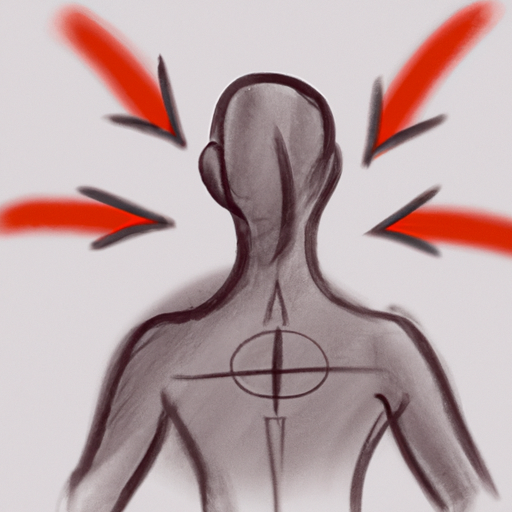Somatic pain, also known as musculoskeletal pain, affects millions of people worldwide and can significantly impact their quality of life. This type of pain originates from the bones, muscles, ligaments, tendons, and joints, making it crucial to understand its causes, symptoms, and diagnosis. In this article, we will delve into the various aspects of somatic pain, providing valuable insights into its diagnosis, treatment options, and strategies for prevention and management. By gaining a comprehensive understanding of somatic pain, individuals can take proactive steps towards finding relief and improving their overall well-being.
1) "Understanding Somatic Pain: Causes, Symptoms, and Diagnosis"
Somatic pain, also known as musculoskeletal pain, is a type of pain that originates from the bones, muscles, ligaments, tendons, and joints of the body. Unlike other types of pain that may involve organs or nerves, somatic pain is localized to the specific area where the injury or damage has occurred. Understanding the causes, symptoms, and diagnosis of somatic pain is essential for effective management and treatment.
Causes:
Somatic pain can arise from various factors, including injuries, trauma, overuse, repetitive movements, poor posture, and degenerative conditions such as arthritis. Accidents, falls, fractures, sprains, strains, and muscle tears can all lead to somatic pain. Inflammatory conditions like tendinitis, bursitis, and myofascial pain syndrome can also contribute to the development of somatic pain.
Symptoms:
The primary symptom of somatic pain is localized discomfort or tenderness in the affected area. The pain is often described as sharp, aching, throbbing, or dull, depending on the underlying cause. Swelling, stiffness, and restricted range of motion may accompany the pain. Somatic pain can limit one’s ability to perform daily activities or participate in physical pursuits, impacting overall quality of life.
Diagnosis:
Accurately diagnosing somatic pain requires a comprehensive evaluation by a healthcare professional. The diagnostic process typically involves a thorough medical history review, physical examination, and possibly imaging studies such as X-rays, MRIs, or CT scans. The healthcare provider will inquire about the location, intensity, duration, and triggers of the pain to determine its origin. They may also perform specific tests to assess muscle strength, joint stability, and range of motion, aiding in the diagnosis of the underlying cause.
Additionally, healthcare professionals may use diagnostic injections or nerve blocks to confirm the source of somatic pain. These procedures involve injecting a local anesthetic or corticosteroid into the suspected area. If the pain is temporarily relieved after the injection, it suggests that the specific site is the source of the pain.
Conclusion:
Somatic pain can significantly impact an individual’s daily life, hindering mobility and causing discomfort. Understanding the causes, symptoms, and diagnostic methods for somatic pain is crucial for developing an effective treatment plan. Once the underlying cause is identified, a combination of treatment approaches may be recommended, including physical therapy, medications, heat or cold therapy, massage, exercise, and lifestyle modifications. By addressing the root cause and managing the symptoms, individuals with somatic pain can regain function, reduce pain, and improve their overall well-being.
2) "Exploring Treatment Options for Somatic Pain: Medications, Therapies, and Lifestyle Modifications"
Somatic pain, also known as musculoskeletal pain, refers to the discomfort or distress that originates from the bones, muscles, ligaments, tendons, or joints. It can be caused by various factors such as injury, inflammation, overuse, or degeneration of tissues. Somatic pain can significantly impact an individual’s quality of life, leading to reduced mobility, sleep disturbances, and emotional distress. However, with appropriate diagnosis and an individualized treatment plan, the symptoms of somatic pain can be effectively managed.
When it comes to treating somatic pain, a multimodal approach involving medications, therapies, and lifestyle modifications is often recommended. This comprehensive approach aims to address the underlying causes, alleviate pain, improve physical function, and enhance overall well-being.
Medications play a crucial role in managing somatic pain. Nonsteroidal anti-inflammatory drugs (NSAIDs) such as ibuprofen or naproxen sodium can help reduce inflammation and relieve pain. Muscle relaxants like cyclobenzaprine or benzodiazepines may be prescribed to alleviate muscle spasms and promote relaxation. In some cases, opioids may be prescribed for short-term use to manage severe pain, but their long-term use is generally avoided due to the risk of dependency and side effects.
Alongside medication, various therapies can assist in managing somatic pain. Physical therapy is often recommended to improve strength, flexibility, and range of motion, as well as to correct any postural imbalances. Techniques such as massage therapy, heat or cold therapy, and transcutaneous electrical nerve stimulation (TENS) can also provide relief by reducing muscle tension and promoting relaxation. In more severe cases, interventions like trigger point injections or nerve blocks may be considered.
In addition to medications and therapies, lifestyle modifications are essential for managing somatic pain. Regular exercise, tailored to an individual’s capabilities and preferences, can help strengthen muscles, improve flexibility, and support overall physical well-being. Maintaining a healthy weight reduces the stress on joints, while a balanced diet rich in nutrients can promote tissue healing and reduce inflammation. Stress management techniques such as meditation, deep breathing exercises, or counseling can also be beneficial in managing pain and improving emotional well-being.
It is vital to emphasize that treatment options for somatic pain should be individualized and tailored to each person’s specific needs. What works for one individual may not necessarily work for another. Therefore, an open and honest dialogue with healthcare professionals is crucial to ensure an accurate diagnosis and the development of an effective treatment plan.
In conclusion, somatic pain can significantly impact an individual’s daily life, but with the right treatment approach, its symptoms can be effectively managed. The combination of medications, therapies, and
3) "Preventing and Managing Somatic Pain: Lifestyle Changes, Self-Care Strategies, and Supportive Resources"
Somatic pain, also known as musculoskeletal pain, is a type of pain that originates from the bones, muscles, ligaments, tendons, and other structures in the body. It can range from mild discomfort to severe and debilitating pain. While medical intervention is often necessary for the diagnosis and treatment of somatic pain, there are also several lifestyle changes, self-care strategies, and supportive resources that can help prevent and manage this type of pain.
One of the key aspects of preventing and managing somatic pain is adopting a healthy lifestyle. Engaging in regular exercise, particularly activities that strengthen the muscles and improve flexibility, can help alleviate muscle imbalances and reduce the risk of developing or worsening somatic pain. It is essential to consult with a healthcare professional or a physical therapist to ensure that the exercise routine is appropriate and tailored to individual needs.
Maintaining a healthy weight is another crucial aspect of preventing and managing somatic pain. Excess weight can put additional strain on the musculoskeletal system, leading to increased pain and discomfort. By adopting a balanced diet and incorporating portion control, individuals can achieve and maintain a healthy weight, thereby reducing the burden on their joints and muscles.
Proper posture and ergonomics play a vital role in preventing somatic pain, especially in individuals who spend prolonged periods sitting or performing repetitive tasks. It is important to maintain good posture while sitting, standing, and lifting heavy objects, as poor posture can strain the muscles and lead to pain. Ergonomic adjustments, such as using an ergonomic chair or keyboard, can also help reduce strain on the body and minimize the risk of developing somatic pain.
Self-care strategies are also effective in managing somatic pain. Applying heat or cold packs to the affected area can help alleviate pain and reduce inflammation. Taking over-the-counter pain medications, such as nonsteroidal anti-inflammatory drugs (NSAIDs), can provide temporary relief. However, it is essential to follow the recommended dosage and consult a healthcare professional if the pain persists or worsens.
Engaging in stress-reducing activities, such as meditation, deep breathing exercises, or yoga, can also help manage somatic pain. Stress can exacerbate pain symptoms, so finding healthy ways to manage and cope with stress is crucial. Additionally, getting enough sleep and practicing good sleep hygiene can contribute to pain management, as lack of sleep can increase pain sensitivity.
Supportive resources are available to individuals suffering from somatic pain. Seeking support from family, friends, or support groups can provide emotional support and a sense of belonging. Physical therapy, chiropractic care, or massage therapy can be beneficial in managing somatic pain, as these therapies aim to improve muscle strength, flexibility, and overall musculoskeletal

